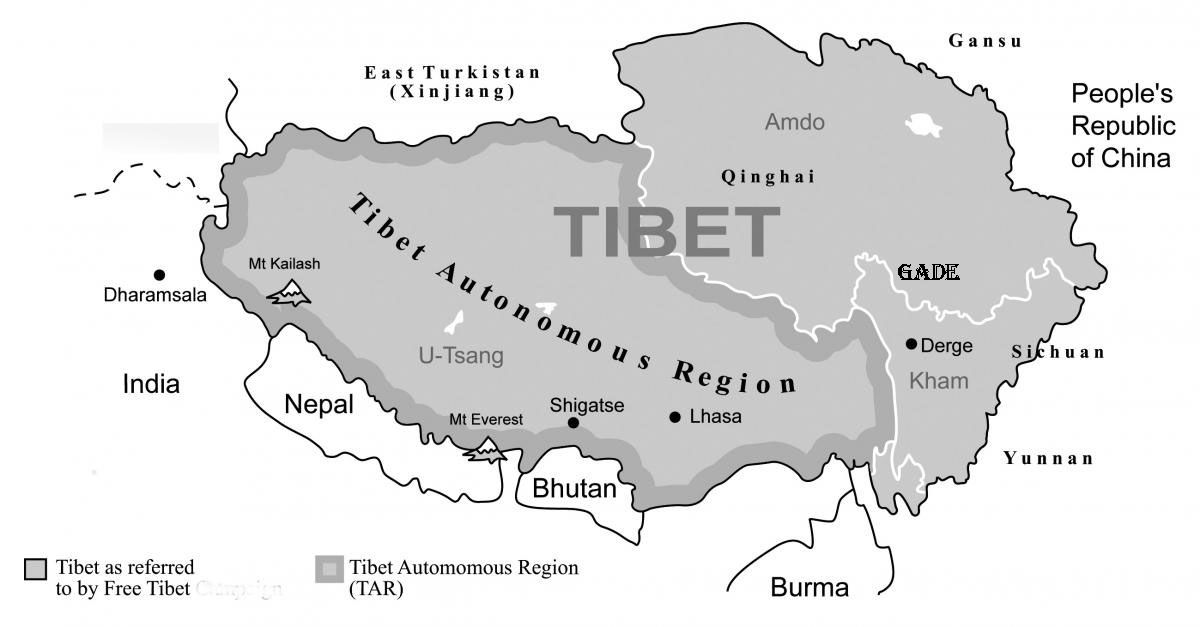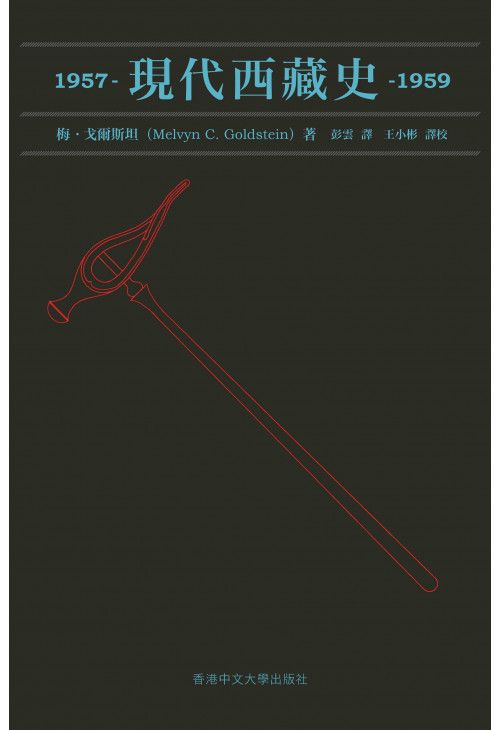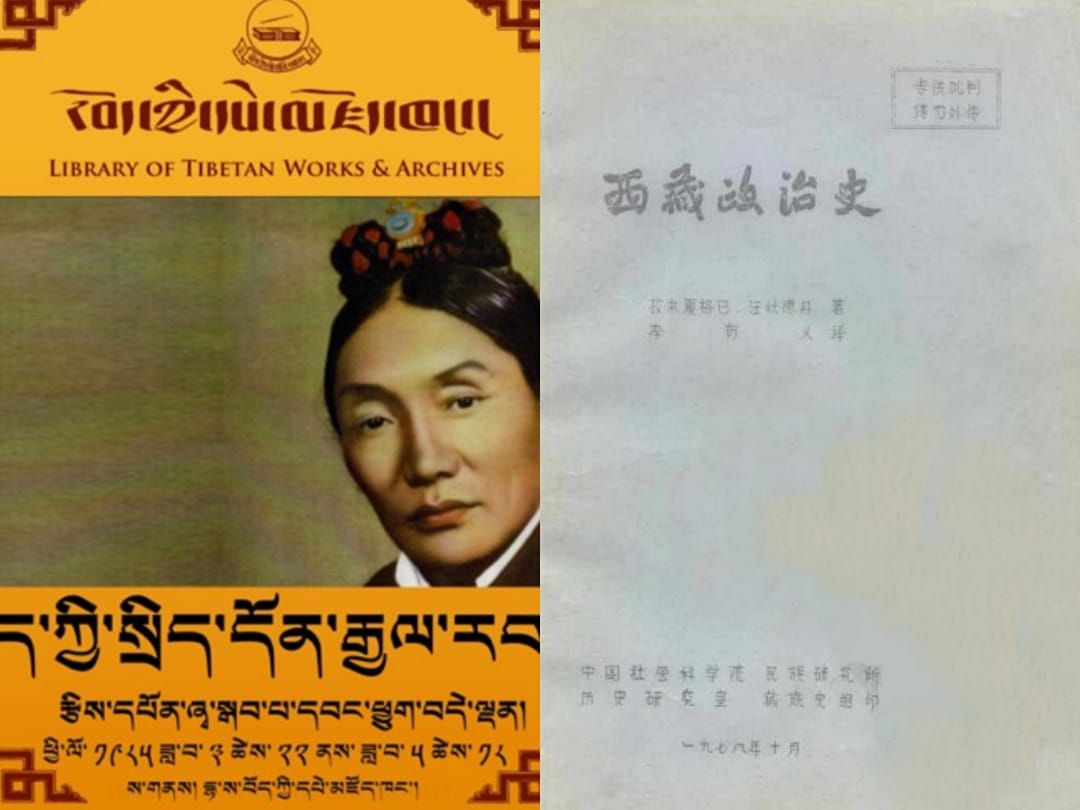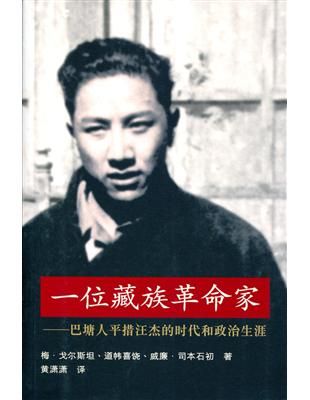
本科历史系在读/gay/藏学爱好者 希望以后从事学术工作。 前豆瓣用户,因为炸号太频繁流亡于此处。欢迎找我讨论历史与时政。
What books do you need to read to understand Tibet? (superior)
I take responsibility for the political and religious rule myself. I have never slackened, and have no time to enjoy myself. I am anxious about the political and religious affairs of the country. I work day and night to make the best decision so that both can prosper. I often think about the farmer's interests, thinking about good strategies to reduce their sorrow and labor, and how to knock on the door of decisiveness, fairness, and justice. - Thirteenth Dalai Lama
For the safety of the people in the snowy region, you and I should do what we can. Although idiots are not convinced, they will not be blinded by ignorance either. This is the motto of the wise. The bleeding of the head is never at the mercy of others! ——Gendun Qunpei, the first humanist intellectual in Tibet
"Please tell the world about the suffering of the Tibetan people." - The last telegram sent to the CIA by CIA-trained telegraph operator, Litang native Atanobu, after witnessing the Dalai Lama crossing the border
stand up! stand up! stand up! Tsampa eaters, get up! Take control of your hometown. - Phuntsok Wangjie
Tibet is not just an idea or an abstract word for me; it is a place, my home. - Tashi Tsering
I will never let any trace of dishonoring the reputation of a hardworking and brave Tibetan descendant be left in my history. ——The 10th Panchen Lama Erdeni
The term "Tibet" as used in this article is synonymous with "(Greater) Tibetan Area", which includes the Tibet Autonomous Region (TAR), Qinghai Province, Gannan Tibetan Autonomous Prefecture in Gansu Province, Aba Tibetan and Qiang Autonomous Prefecture in Sichuan Province, and Ganzi Tibetan Autonomous Prefecture , Yunnan Diqing Tibetan Autonomous Prefecture, including the general name of the vast area.

In addition, India's Ladakh region, Sikkim, Nepal's Mustang, and Bhutan also belong to the Tibetan cultural circle in a broad sense. I will introduce related books in future articles.
Guide book :
1. "Sky Burial: The Destiny of Tibet"
by Wang Lixiong
Wang Lixiong is a writer and dissident in mainland China whose novel "The Yellow Peril" was secretly circulated by many mainland intellectuals at the turn of the millennium, which made him famous in liberal circles. His wife, Tsering Woeser, is the most famous dissident among Tibetans in the country, and together they tell the truth about Tibet to the world. This book introduces the history of the relationship between Tibet and Han and the origin of the Tibet issue in a neutral and sincere tone. The cited materials are detailed and the writing is easy to understand. I personally think that anyone interested in Tibetan history and Tibetan issues should start by reading this book and add some background knowledge before going deeper into Tibet.

Download link: Sky Burial: The Destiny of Tibet | Wang Lixiong | download (book4you.org)
2. "Snow Lion and Dragon"
【US】May Goldstein
May Goldstein is one of the most well-known and outstanding Tibetan scholars today. He has spent decades of his career in Tibetology, and has done a lot of groundbreaking work for the study of modern Tibetan history. The snow lion is the symbol of Tibet, and the dragon is the symbol of China. As the name suggests, this book is a brief history of Tibetan-Chinese relations. In this book, Mr. Goldstein discusses the history of Sino-Tibetan relations in different dynasties in ancient times, expresses some of his personal views on current Tibet issues, and forecasts future Sino-Tibetan relations. However, this book was written earlier, and the content after Deng Xiaoping did not cover much, and the judgment of the situation was too optimistic.

Download link: Snow Lion and Dragon (wordpress.com)
Modern History of Tibet:
1. "The Fall of the Lama Kingdom"
【US】May Goldstein

This book is the first volume of a four-volume modern history of Tibet by Mr. May Goldstein, a well-known Tibetan scholar, who is also well-known in the Chinese-speaking world. The reason why it can be translated and published in the mainland is because it does not involve sensitive content after 1951. It mainly tells how the Kashag regime in Tibet, which was in a state of actual independence after the 1911 Revolution, protected itself and attempted modernization under the siege of Russia, Britain and the middle forces. a piece of history. The 13th Dalai Lama was a fickle and astute statesman, whose years of exile had broadened his horizons, and upon his return he decided to carry out top-down reforms. For him, the resistance to reform was not only the strong conservative aristocracy and monks, but also the potential revolutionary forces arising from the reform. How to maintain Tibet's hard-won freedom, promote the development of Tibetan society, and maintain his own power has become a question he pondered day and night. However, the death of the thirteenth Dalai Lama and the frequent infighting among the nobles finally made Tibet a missed opportunity and had to face the newly established People's Republic of China.
Mr. Goldstein's wife is the daughter of a Kalon (equivalent to a minister) in the Kashag government, and he himself knows Chinese officials in Tibetan affairs, which allows him to come into contact with a large number of precious historical materials preserved by Tibetans in exile and the involvement of the CCP through his personal connections. Tibetan archives, so this book is the first choice for understanding modern Tibetan history. Although the book was published with permission from the mainland authorities, the assigned translator still deliberately "mistranslated" the contents in many places. For details, please refer to Ding Yifu: Academic Translation Invaded by Politics - Talking about the translation of the Chinese version of "The Fall of the Lama Kingdom" .
I personally speculate that the authorities want to use this book to show the internal strife and failed reforms of the Kashag government to promote the legitimacy of their control over Tibet, but in real life, this book has instead made many young Tibetans start to care about the history of their own nation and future destiny.
Download Link: The Fall of the Lama Kingdom | Melvyn C. Goldstein | download (book4you.org)
2. "Modern History of Tibet, Volume II 1951-1955: The Calm Before the Storm"
【US】May Goldstein
This volume mainly tells the history of the Kashag government's acceptance of the Seventeen-Article Agreement under force in 1951 to the end of the 14th Dalai Lama's trip to the mainland in 1955. During this period, the Kashag government and the traditional system were preserved, and they coexisted with the CCP's organs for governing Tibet, forming a fragile balance. This situation is very similar to Mongolia from 1921 to 1924 and Cambodia before Prince Sihanouk went into exile. Although the "old forces" and "revolutionaries" were in a state of cooperation, they did not fully trust each other. Plan, conflicts will break out at any time. As the subtitle "The Calm Before the Storm" puts it, this period was the calmest since Tibet's "peaceful liberation", and the Dalai Lama got along well with the CCP's key leaders in the interior. Most people do not expect that the Tibet issue will develop to such a degree in the future...

Download Link: Modern History of Tibet 1951–1955: The Calm Before the Storm | Mei . Goldstein | download (book4you.org)
3. "Modern History of Tibet: 1955-1957"
【US】May Goldstein
A few years ago, Mr. Goldstein set a flag saying that he would complete the rest of the "Modern History of Tibet" in the third volume, but he was not able to complete the third volume, which was originally scheduled to be a three-volume "Modern History of Tibet". The History of Tibet became a four-volume edition. Although Mr. Goldstein broke his promise, this volume is as exciting as the first two volumes. This volume focuses on Tibet from 1955 to 1957. During this period, the CCP’s “socialist transformation project” in Sichuan spread to Kham, where large-scale uprisings broke out, causing cracks in the relationship between the CCP and the Kashag regime. At the same time, Gyalo Thondup, the elder brother of the 14th Dalai Lama, the noble Ziben Shakabpa (we will introduce his works below), and the monk Lobsang Gyaltsen established the anti-communist organization Drekandsong in India , hoping to challenge the CCP’s rule. The Kashag government in Lhasa and the Dalai Lama himself did not know about it, and they still cooperate with the CCP. Under such circumstances, Fan Ming, the CCP official in charge of Tibet, wanted to carry out "democratic reforms" as soon as possible to strengthen control over Tibet, but Mao Zedong thought there was no need to rush things...

Download Link: A History of Modern Tibet: 1955–1957 | Melvyn C. Goldstein | download (book4you.org)
4. "Modern History of Tibet: 1957-1959"
【US】May Goldstein
In 2021, the translation and introduction of the Chinese version of the four-volume "History of Modern Tibet" will come to a perfect conclusion, and those who are concerned about Tibet issues will finally be able to know the specific situation in Tibet before and after the 14th Dalai Lama's escape. The best part of this book is the chapter on the four rivers and six hills, a rebel group led by the Kangba people. In these short three years, the situation in Tibet has deteriorated rapidly, the Kham region has once again revolted, and the CCP's policies have also been radicalized. On March 10, 1959, the people in Lhasa surrounded Norbulingka and asked the Dalai Lama not to go to the Tibet Military Command to watch the drama. The incident eventually developed into a large-scale riot, and the CCP increased its troops to suppress it. In this emergency situation, the Dalai Lama and the Tibetan people who support him made a decisive decision and started the road of exile to save the fire of resistance.

Download Link: A History of Modern Tibet 1957–1959 | May Goldstein | download (book4you.org)
5. "Tibetan Political History"
By Zibin Shakabpa Wangchudeten
Shakabpa, a young and promising son of a nobleman, became Zibon (Minister of Finance) of the Kashag government in his thirties, and he has been calling himself Zibon Shakabpa ever since. This honorable title like "Ibrahim Pasha" is well-known in the international Tibetan academic circle, not only because of his high-profile political activities, but also because he wrote the first book on Tibetan politics written by Tibetans in English. history. The purpose of writing this book is to demonstrate Tibet's position in history and its true relationship with the Han region. It has a strong political purpose, but the arguments and narratives are very exciting. Shakabpa put forward the concept of "offering relationship" between Tibet and the Yuan Dynasty, and believed that ancient international relations could not be discussed with general international relations theories. After "Tibetan Political History" was published by Yale University, it was well received by European and American academic circles. Since then, "the relationship between supply and donor" has become a hot topic in Tibetan studies. In order to meet the challenges brought by this book, the CCP authorities established the Tibetan Academy of Social Sciences to produce research results that are beneficial to itself. "How big.

PS T. Wiley, the inventor of Wiley's Latin transcription of Tibetan, participated in the editing of this book.
6. "A Tibetan Revolutionary: The Times and Political Career of Phuntsok Wanggye from Batang"
【America】May Goldstein, Daowan Xirao, William Spencer
In modern times, nationalists in many Asian and African countries have turned to communism in order to liberate their nations, and the Leninist theory of imperialism and colonial liberation is the most attractive part to them. Phuntsok Wanggye, a Kham man, was a Tibetan revolutionary who was attracted by red, and he longed to build a modern Tibet. Like Ulanfu in Southern Mongolia and Saifuding in Uyghur, he chose to cooperate with the CCP to build a socialist country with equal ethnicity and fight for the rights of Tibetans within this framework. He opened the way for the CCP army to enter Tibet, and persuaded the Kashag government and the Dalai Lama to cooperate with the CCP, but the CCP did not give Tibet the rights it deserved. Phuntsok Wanggye, a former "advanced element", was imprisoned and tortured. In his later years, he still believed that the CCP could grant Tibet autonomy, and repeatedly called on the CCP to reconcile with the Dalai Lama. This book is his memoir, telling the modern and modern history of Tibet from the perspective of a Tibetan revolutionary. Reading this book can help you learn about the revolutionary thought in modern Tibet that the CCP deliberately does not mention. This book is best read in contrast to the previous one, the contrast between the aristocratic perspective and the revolutionary perspective is very interesting.

Download Link: A Tibetan Revolutionary | Melvyn C. Goldstein, Dawei Sherap, William R. Siebenschuh | download (book4you.org)
7. "My Hometown and People"
The Fourteenth Dalai Lama
A thin memoir, in which the Dalai Lama recounts his studies as a reincarnation and the political events he experienced after becoming a reincarnation. This book has a strong political orientation, but it is still an important source for the study of Tibetan issues. The Dalai Lama himself has changed his attitude towards the CCP many times, which is closely related to the changes in the CCP's policy of governing Tibet. We will find that his old man is not as "reactionary" and "extreme" as the CCP propaganda, and he is also an enlightened person who pursues modernization and has never given up on the middle line.
Download link: Dalai Lama Dalai Lama - My Hometown and People.pdf | Dalai Lama Dalai Lama | download (book4you.org)
8. "Freedom in Exile"
The Fourteenth Dalai Lama
This book is the Dalai Lama's recollection of his life in exile, and can be regarded as a companion piece to the previous book.
Download link: Dalai Lama Dalai Lama - Freedom in Exile | Dalai Lama Dalai Lama | download (book4you.org)
9. "Dragon in the Snow"
By Tsering Xia
Tsering Shaka is a left-wing Tibetan scholar in exile who is now a researcher at the University of British Columbia. In this book, Tsering Shaga believes that Tibet lost its hard-won freedom mainly because of the corruption and incompetence of the nobles, which ruined the modernization of Tibet. Tsering Shaka did not blindly condemn the CCP's rule, but objectively pointed out that the Tibet issue was the result of conflicting interests, mutual misunderstandings, secret calculations and political expediency, and believed that the Tibetan uprising was by no means simply "incited by foreign forces". "And there is a very strong public opinion foundation behind this. As Tsering Shaga said, the Tibetan-Chinese conflict will never disappear after the material conditions in Tibet are improved, because the Chinese have never faced the demands of the Tibetans. As long as the CCP does not carry out a sincere dialogue, the Tibet issue will always exist.
If you are on the left, you can start with this book to understand the Tibet issue.

Download link: The Dragon in the Land of Snows | Tsering Shakya | download (book4you.org)
In addition, Tsering Shajia is also a frequent visitor to the American "New Left Review" and Taiwan's "Thought" magazine, and has published many sharp editorials and wonderful book reviews:
Invisible Tibet ~ Woeser: Interview with Tsering Shaka: Tibet Issues (middle-way.net)
Invisible Tibet ~ Woeser: Tsering Shakya: Prisoner (middle-way.net)
Invisible Tibet ~ Woeser: Tsering Shakya: Protesting the Shift in Language (middle-way.net)
10. "Tibet is my home"
Tashi Tsering dictated by Mei Goldstein and written by William Situ Shichu
Tashi Tsering was born into a peasant family. When he was a teenager, he was a musician in the Lhasa court song and dance troupe. Later, he studied in India and the United States. After returning to Tibet in the 1960s, he was involved in the cultural revolution. freed. In his later years, Tashi Tsering devoted himself to education in Tibet and started to compile an English-Tibetan-Chinese trilingual dictionary. Although Tashi Tsering disagrees with the Tibetans in exile, he still respects the Dalai Lama and hopes that the CCP will negotiate sincerely with the Dalai Lama. This book shows the social changes in Tibet from the perspective of civilians. Tashi Tsering tells the struggle history of a Tibetan and a nation with a rare candor.
The simplified Chinese version of this book is abridged, especially the content of Tashi Tsering's trip to India to meet the Dalai Lama. I didn't find the traditional Chinese version of the resource from Mingjing, so I put the link to the English version, please read it for comparison.

Download link: Tibet is my home | Tashi Tsering dictation. Melvin & Goldstein translation | download (book4you.org)
The Struggle for Modern Tibet | Tashi Tsering | download (book4you.org)
11. "Heart to Freedom: A CCP Military Officer Who Shared Weal and woe with Tibetans"
Tsering is prosperous
During the resistance movement in Tibet in the 1950s, there was a Han Chinese PLA officer who also joined the Sishui Liugang organization, Jiang Huating. Jiang Huating was assigned to Tibet as an artillery officer in the 1950s, but he chose to fight against the CCP with the Khampa people and became Luosang Tashi, who was arrested by the CCP with a reward of 40,000 silver dollars. Due to the cooperation of the Nepalese government with the CCP's encirclement and suppression, most of the members of the four rivers and six hills died in the foothills of the Himalayas, but Jiang Huating miraculously survived and spent the rest of his life in the Tibetan community in India. This book is not only about the content of the protests in Tibet, but also about the civil war between the Kuomintang and the Communist Party and land reform. It is a very important material.
Download link: Heart to Freedom 6.pdf (xizang-zhiye.org)
12. The Book of Seventy Thousand Words
Written by the 10th Panchen Lama Erdeni
The full title is "Report on the General Situation and Specific Situation in Tibet and the Ups and Downs of Tibet-based Tibetan Areas and Future Hopes and Requests". Because there are about 70,000 characters in Chinese, it is also called "Seventy Thousand Words". This is an investigation report raised by the 10th Panchen Lama, who had worked with the CCP, to Beijing in 1962. This article exposed the atrocities committed by the CCP against Tibet, which resulted in the Panchen Lama being imprisoned for several years. Although the Panchen Lama still had illusions about the CCP emotionally, he did not hesitate to sacrifice his personal safety and loudly appealed to people to pay attention to the suffering in Tibet. His final passing away was also full of doubts. Many people believed that he was poisoned because the CCP found that the Panchen Lama, who had always been pro-Han in history, could no longer be firmly controlled.
Download link: Book of Seventy Thousand Words | The 10th Panchen Lama Erdeni | download (book4you.org)
To be continued~
Like my work?
Don't forget to support or like, so I know you are with me..
Comment…